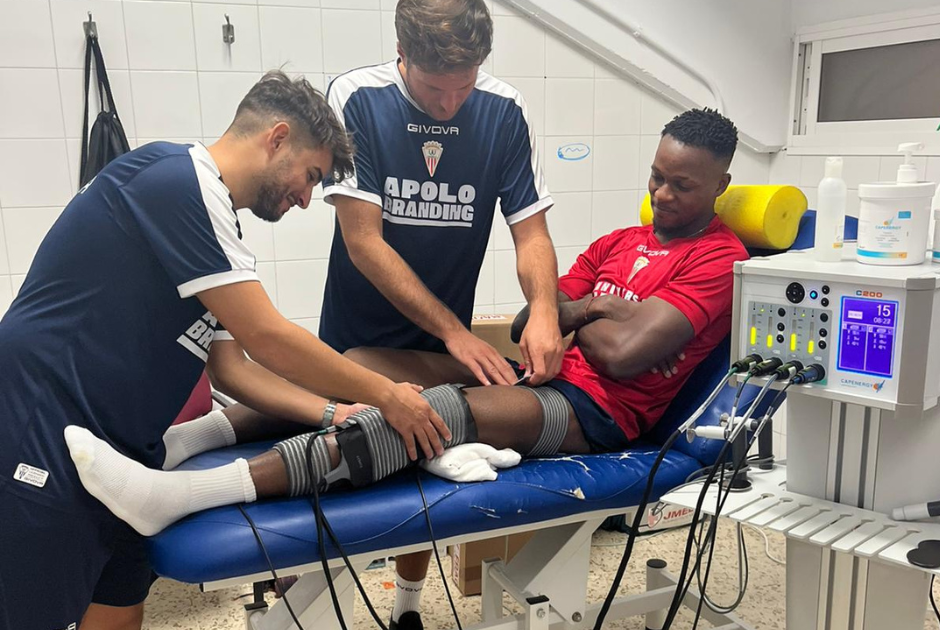
Stress fractures are a common injury among athletes, especially in disciplines such as football or basketball, which submit the bones to repetitive and prolonged loading. Small cracks in the bone are characteristic of this type of fractures and they can get worse if not treated correctly.
Important players such as Jesús Navas of Sevilla Fútbol Club or David Villa of Fútbol Club Barcelona have suffered this injury, removing them from the playing field for at least four to six weeks. When Neymar joined Paris Saint-Germain in 2017 from FC Barcelona, he suffered a fracture of the right foot, significantly affecting his performance due to a series of consecutive injuries. And recently Aurélien Tchouaméni from Real Madrid also suffered a fracture of the second metatarsal bone of the left foot after a Clásico against Barcelona, which basically left him disabled for the rest of the 2023 season.
Discover in this blog what an athlete ‘s stress fracture is and how to efficiently treat this injury to assure a speedy recovery and return to play. We’ll explain the symptoms, offer innovative treatments and highlight the importance of technology in physiotherapy to speed up rehabilitation.
What is a stress fracture?
A stress fracture is a slowly evolving injury caused by a repetitive excess loading on a bone, leading to small cracks which can become bigger over time when not treated adequately.
Athletes commonly suffer these injuries in areas such as the foot, specifically the fifth metatarsal bone, and the lower part of the foot, due to the intense physical demand these bones are subjected to during training and competition, with repetitive loading and constant pressure on these bones while running, jumping or making sudden turns.

Symptoms of stress fracture
Typical symptoms of stress fractures include:
- Pain in the affected bone: The pain is generally localized and can increase with physical activity or loading on the affected area.
- Increased pain when in use: The pain can intensify with movement or specific physical activity that implies the injured bone.
- Swelling: The affected area looks swollen and is often sensitive to the touch.
Furthermore, when not treated correctly, stress fractures can evolve and turn into a complete fracture of the affected bone. This significantly prolongs the recovery time of the athlete and can affect his general condition, as well as delay his return to play.
This is why a timely diagnosis of the symptoms and an adequate treatment are crucial to efficiently deal with a stress fracture, minimizing its impact on an athlete’s career and assuring a speedy and complete recovery.
Treating stress fractures with Capenergy
Thanks to the advances in medical technology, such as the Capenergy TECAR EVOLUTION devices, the treatment of stress fractures has improved significantly.

These devices allow speeding up the recovery times through the application of second generation radiofrequency.
Benefits of Capenergy Technology
More and more physiotherapy centers count on Capenergy’s second generation radiofrequency technology to shorten their patients’ recovery times. The following relevant benefits are obtained in the treatment of stress fractures:
- Reduced inflammation: TECAR EVOLUTION technology helps reduce inflammation and helps reabsorbing bruises faster, thus enabling faster bone healing.
- Fluid mobilization: The mobilization of blood and lymph fluid boosted by Capenergy’s radiofrequency devices speeds up recovery, minimizing muscular dystrophy and improving the athlete’s rehabilitation.
- Reduction of recovery times: The healing process of the largest bruises, causing pain and inflammation, is reduced from approximately 3 months to 10 or 12 days with Capenergy technology.
- Anti-inflammatory and analgesic effect of treatment with a Capenergy radiofrequency device, which furthermore avoids the fibrosis accompanying traumatic injury.
- Versatile treatments: With devices such as the TECAR EVOLUTION C-200, manual capacitive and resistive treatment can be performed simultaneously, or one can perform a mixed automatic and manual treatment, to optimize the treatment according to the patient’s specific needs.
Application of Capenergy in professional sports
In the professional sports field, not only does Capenergy’s technology shorten recovery times, it is also used as a part of the warming up before accessing the playing field, as a preparation of the athletes prior to undergoing surgery and as an integral part of the rehabilitation process.
This significantly contributes to the reduction of the time needed to return to play (RTP) , crucial for sports clubs and physiotherapists looking for a fast and efficient recovery.

Without any doubt, treatment with automatic plates is essential in the treatment of sports injuries. Capenergy’s technology allows the therapist to combine treatments of the upper limbs, lower limbs and chest at the same time, making a more efficient use of the treatment time and improving the athlete’s recovery.
However, it is important to start rehabilitation immediately after injury and keep it up until the athlete can go back to performing his activities without being restricted by the injury.
In a nutshell, Capenergy’s technology offers a significant advance in the treatment of stress fractures, as well as other sports injuries, offering fast and efficient results for both elite athletes and amateurs.
Would you like to know more about Capenergy’s radiofrequency and how it can help in the treatment of different ailments at your clinic? Request a free demo.